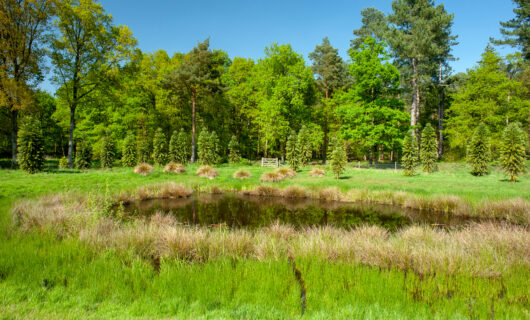The New Essex Wildlife Corridor comes to Markshall’s Arboretum
An exciting project has started in Markshall’s Arboretum. More than 2,000 hazels have been planted forming a small corridor from the 800-year-old Honywood Oak and encompassing a series of old air raid shelters now converted into bat hibernaculums. The hazels have been planted by Markshall staff, volunteers and with the help of volunteers from Essex County Council on Tuesday 14 November all with the aim of encouraging an array of wildlife.

As an environmental charity, we’re on a mission not only to aid conservation efforts, but also inspire communities to take steps to protect wildlife and help tackle climate change. The Arboretum at Markshall has seen many developments in its extensive history; from new geographic zones to a replica of the foothills of the Himalayas – there is no end to the team’s ideas and enthusiasm.
The latest project has seen more than 1,000 hazels planted surrounding ancient trees and air raid shelters to form a wildlife corridor. The area which has been developed sits in the Europe geographic zone of the Arboretum and is an area the team have been keen to develop for many years. Starting close to the 800-year-old Honywood Oak and curving behind the ancient Screaming Oak, the wildlife corridor is expected to support already thriving wildlife populations at the estate and form new habitats.



Markshall is nationally important for bat conservation with the very rare Barbestelle Bat – with only a few known breeding sites in Britain, including Markshall. The wildlife corridor will also support important pollinators, woodland animals, and butterflies – another big conservation project at the estate. Supporting wildlife has never been more important, with the impacts of climate change being felt locally, nationally, and internationally. Markshall hopes that this project will inspire families to consider smaller-scale projects at home or even to participate with local projects.
The history of Markshall goes back at least to the Domesday survey of 1086. For much of its 1,000-year history the Arboretum, as we know it today, was home to around 300 heritage oaks. It also included a deer park for many decades. The new plantings are a nod to this part of Markshall’s heritage.
What makes this project even more exciting is that on Tuesday 14 November, Markshall welcomed a group of volunteers from the Children and Families, Commissioning Team at Essex County Council. The day consisted of hazel planting, clearing land and building bug hotels – all with the joint goal of creating a wildlife corridor to support important species.
The partnership is a joining of Markshall’s underlying conservation aims and Essex County Council’s carbon literacy training where staff pledge to make personal and team changes efforts to reduce their carbon footprint. With a £200 million Essex County Council Climate Action Plan at the very start of its roll-out, it is their priority that all members and officers can now have a well-rounded understanding of climate change and how they can go about achieving their carbo neutrality target. But it is more than just a tick-box exercise for the team, hence their decision to focus on conservation in a practical setting, making their volunteer day at Markshall the perfect activity for the team to complete.
We’re excited to see how this area will develop over the years. Please do follow along with us on our social media pages.
More news
See more
-

Happy 17th Birthday to one of the largest collections of Wollemi pines in Europe!
Thursday, 17th October 2024, marks 17 years since a collection of one of the world’s rarest trees was planted in […]
-

Rembering Jonathan Jukes
The Trustees were very sad to learn that Jonathan Jukes who worked at Markshall from 1985 until 2018 has died, […]
-

Essex County Council Volunteers Revitalize Historic Iron Bridge and Arboretum Bridge
Last week, the historic Markshall saw a heartwarming display of community spirit as volunteers from Essex County Council dedicated their […]